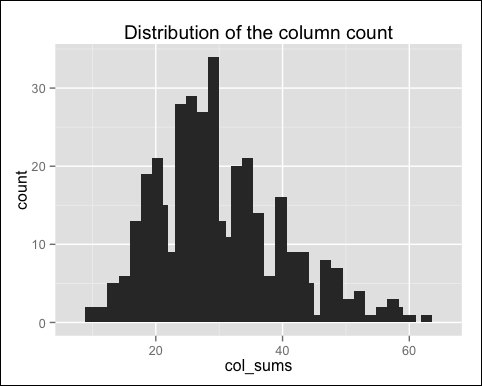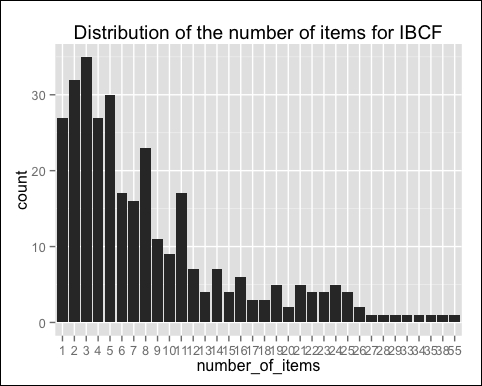Collaborative filtering is a branch of recommendation that takes account of the information about different users. The word "collaborative" refers to the fact that users collaborate with each other to recommend items. In fact, the algorithms take account of user purchases and preferences. The starting point is a rating matrix in which rows correspond to users and columns correspond to items.
This section will show you an example of item-based collaborative filtering. Given a new user, the algorithm considers the user's purchases and recommends similar items. The core algorithm is based on these steps:
- For each two items, measure how similar they are in terms of having received similar ratings by similar users
- For each item, identify the k-most similar items
- For each user, identify the items that are most similar to the user's purchases
In this chapter, we will see the overall approach to building an IBCF model. In addition, the upcoming sections will show its details.
We will build the model using a part of the MovieLense dataset (the training set) and apply it on the other part (the test set). Since it's not a topic of this chapter, we will not evaluate the model, but will only recommend movies to the users in the test set.
The two sets are as follows:
The algorithm automatically normalizes the data, so we can use ratings_movies that contains relevant users and movies of MovieLense. We defined ratings_movies in the previous section as the subset of MovieLense users who have rated at least 50 movies and movies that have been rated at least 100 times.
First, we randomly define the which_train vector that is TRUE for users in the training set and FALSE for the others. We will set the probability in the training set as 80 percent:
which_train <- sample(x = c(TRUE, FALSE), size = nrow(ratings_movies), replace = TRUE, prob = c(0.8, 0.2)) head(which_train) ## [1] TRUE TRUE TRUE FALSE TRUE FALSE
Let's define the training and the test sets:
recc_data_train <- ratings_movies[which_train, ] recc_data_test <- ratings_movies[!which_train, ]
If we want to recommend items to each user, we could just use the k-fold:
- Split the users randomly into five groups
- Use a group as a test set and the other groups as training sets
- Repeat it for each group
This is a sample code:
which_set <- sample(x = 1:5, size = nrow(ratings_movies), replace = TRUE)
for(i_model in 1:5) {
which_train <- which_set == i_model
recc_data_train <- ratings_movies[which_train, ]
recc_data_test <- ratings_movies[!which_train, ]
# build the recommender
}In order to show how this package works, we split the data into training and test sets manually. You can also do this automatically in recommenderlab using the evaluationScheme function. This function also contains some tools to evaluate models that we will use in the Chapter 4, Evaluating the Recommender Systems, which is about model evaluation.
Now, we have the inputs to build and validate the model.
The function to build models is recommender and its inputs are as follows:
- Data: This is the training set
- Method: This is the name of the technique
- Parameters: These are some optional parameters of the technique
The model is called IBCF, which stands for item-based collaborative filtering. Let's take a look at its parameters:
recommender_models <- recommenderRegistry$get_entries(dataType = "realRatingMatrix") recommender_models$IBCF_realRatingMatrix$parameters
|
Parameters |
Default |
|---|---|
|
|
|
|
|
|
|
|
|
|
|
|
|
|
|
|
|
|
|
|
|
Some relevant parameters are as follows:
k: In the first step, the algorithm computes the similarities among each pair of items. Then, for each item, it identifies its k most similar items and stores it.method: This is the similarity function. By default, it isCosine. Another popular option ispearson.
At the moment, we can just set them to their defaults. In order to show how to change parameters, we are setting k = 30, which is the default. We are now ready to build a recommender model:
recc_model <- Recommender(data = recc_data_train, method = "IBCF", parameter = list(k = 30))recc_model ## Recommender of type 'IBCF' for 'realRatingMatrix' ## learned using 111 users. class(recc_model) ## [1] "Recommender" ## attr(,"package") ## [1] "recommenderlab"
The recc_model class is an object of the Recommender class containing the model.
Using getModel, we can extract some details about the model, such as its description and parameters:
model_details <- getModel(recc_model) model_details$description ## [1] "IBCF: Reduced similarity matrix" model_details$k ## [1] 30
The model_details$sim component contains the similarity matrix. Let's check its structure:
class(model_details$sim) ## [1] "dgCMatrix" ## attr(,"package") ## [1] "Matrix" dim(model_details$sim) ## [1] 332 332
As expected, model_details$sim is a square matrix whose size is equal to the number of items. We can explore a part of it using image:
n_items_top <- 20
image(model_details$sim[1:n_items_top, 1:n_items_top], main = "Heatmap of the first rows and columns")
The following image displays heatmap of the first rows and columns:

Most of the values are equal to 0. The reason is that each row contains only k elements. Let's check it:
model_details$k ## [1] 30 row_sums <- rowSums(model_details$sim > 0) table(row_sums) ## row_sums ## 30 ## 332
As expected, each row has 30 elements greater than 0. However, the matrix is not supposed to be symmetric. In fact, the number of non-null elements for each column depends on how many times the corresponding movie was included in the top k of another movie. Let's check the distribution of the number of elements by column:
col_sums <- colSums(model_details$sim > 0)
Let's build the distribution chart:
qplot(col_sums) + stat_bin(binwidth = 1) + ggtitle("Distribution of the column count")The following image displays the distribution of the column count:

As expected, there are a few movies that are similar to many others. Let's see which are the movies with the most elements:
which_max <- order(col_sums, decreasing = TRUE)[1:6] rownames(model_details$sim)[which_max]
|
Movie |
col_sum |
|---|---|
|
|
|
|
|
|
|
|
|
|
|
|
|
|
|
|
|
|
Now, we are able to recommend movies to the users in the test set. We will define n_recommended that specifies the number of items to recommend to each user. This section will show you the most popular approach to computing a weighted sum:
n_recommended <- 6
For each user, the algorithm extracts its rated movies. For each movie, it identifies all its similar items, starting from the similarity matrix. Then, the algorithm ranks each similar item in this way:
- Extract the user rating of each purchase associated with this item. The rating is used as a weight.
- Extract the similarity of the item with each purchase associated with this item.
- Multiply each weight with the related similarity.
- Sum everything up.
Then, the algorithm identifies the top n recommendations:
recc_predicted <- predict(object = recc_model, newdata = recc_data_test, n = n_recommended) recc_predicted ## Recommendations as 'topNList' with n = 6 for 449 users.
The recc_predicted object contains the recommendations. Let's take a look at its structure:
class(recc_predicted) ## [1] "topNList"## attr(,"package")## [1] "recommenderlab" slotNames(recc_predicted) ## [1] "items" "itemLabels" "n"
The slots are:
items: This is the list with the indices of the recommended items for each useritemLabels: This is the name of the itemsn: This is the number of recommendations
For instance, these are the recommendations for the first user:
recc_predicted@items[[1]] ## [1] 201 182 254 274 193 297
We can extract the recommended movies from recc_predicted@item labels:
recc_user_1 <- recc_predicted@items[[1]]movies_user_1 <- recc_predicted@itemLabels[recc_user_1] movies_user_1
|
Index |
Movie |
|---|---|
|
|
|
|
|
|
|
|
|
|
|
|
|
|
|
|
|
|
We can define a matrix with the recommendations for each user:
recc_matrix <- sapply(recc_predicted@items, function(x){
colnames(ratings_movies)[x]
})
dim(recc_matrix)
## [1] 6 449Let's visualize the recommendations for the first four users:
recc_matrix[, 1:4]
|
|
|
|
|
|
|
|
|
|
|
|
|
|
|
|
|
|
|
|
|
|
|
|
|
|
|
|
|
|
|
|
|
|
|
|
Now, we can identify the most recommended movies. For this purpose, we will define a vector with all the recommendations, and we will build a frequency plot:
number_of_items <- factor(table(recc_matrix))chart_title <- "Distribution of the number of items for IBCF"
Let's build the distribution chart:
qplot(number_of_items) + ggtitle(chart_title)
The following image shows the distribution of the number of items for IBCF:

Most of the movies have been recommended only a few times, and a few movies have been recommended many times. Let's see which are the most popular movies:
number_of_items_sorted <- sort(number_of_items, decreasing = TRUE) number_of_items_top <- head(number_of_items_sorted, n = 4) table_top <- data.frame(names(number_of_items_top), number_of_items_top) table_top
|
names.number_of_items_top | |
|---|---|
|
|
|
|
|
|
|
|
|
|
|
|
The preceding table continues as follows:
|
number_of_items_top | |
|---|---|
|
|
|
|
|
|
|
|
|
|
|
|
IBCF recommends items on the basis of the similarity matrix. It's an eager-learning model, that is, once it's built, it doesn't need to access the initial data. For each item, the model stores the k-most similar, so the amount of information is small once the model is built. This is an advantage in the presence of lots of data.
In addition, this algorithm is efficient and scalable, so it works well with big rating matrices. Its accuracy is rather good, compared with other recommendation models.
In the next section, we will explore another branch of techniques: user-based collaborative filtering.
